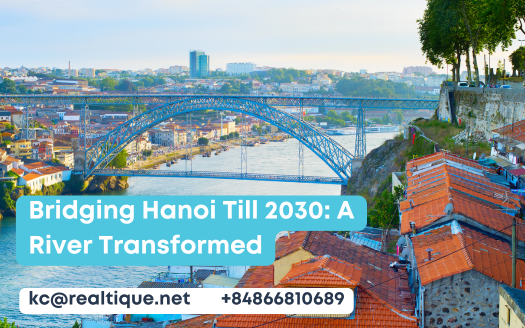Bridging Hanoi Till 2030: A River Transformed
The alteration of Hanoi’s river infrastructure, particularly through the development of significant bridges like Long Bien and Nhat Tan, reflects a crucial shift in urban connectivity and economic importance. These structures have served not only as physical links between communities but also as catalysts for regional development and cultural exchange. As the city anticipates the construction of nine additional bridges by 2030, the implications of these developments on sustainable urban growth and community interactions warrant a closer examination. What challenges and opportunities lie ahead in this ambitious vision for Hanoi’s future?
Table of Contents
The historical significance of the Red River bridges in Hanoi is highlighted by their role as essential conduits for transportation and cultural exchange in the region.
The iconic Long Bien Bridge, constructed by the French in the early 20th century, marked the beginning of modern infrastructure connecting the capital with surrounding areas. Spanning 2,290 meters, it facilitated both road and rail traffic, symbolizing Hanoi’s economic and cultural growth.
Over the decades, additional bridges have emerged, enhancing connectivity and promoting socio-economic development. Each structure reflects the changing engineering capabilities and the increasing demands of urbanization.
Together, these bridges have shaped the scenery of Hanoi, encouraging interactions among communities and facilitating the flow of goods, ideas, and people across the Red River.
Recent advancements in bridge construction across the Red River have significantly contributed to Hanoi’s transportation infrastructure, reflecting the city’s commitment to modernizing its connectivity.
Notable projects include the completion of the Vinh Thinh Bridge in 2014, the longest river bridge in Vietnam, measuring 5.4 km. The Nhat Tan Bridge, opened in 2015, further enhanced traffic capacity with its 3.9 km span and eight lanes for vehicles.
The recently completed Van Lang Bridge, a public-private partnership, connects Hanoi with Phu Tho, facilitating regional travel. These developments not only alleviate congestion but also support socio-economic growth, demonstrating Hanoi’s strategic focus on improving urban mobility and enhancing access to various districts.
Future plans include the construction of nine additional bridges by 2030, emphasizing ongoing infrastructural expansion.
Innovation in engineering and design has become paramount in the development of bridges across the Red River, reflecting a commitment to enhancing both safety and functionality.
Modern bridges incorporate advanced materials and construction techniques, ensuring durability and resilience against environmental challenges. Multi-lane designs cater to diverse vehicle types, improving traffic flow and minimizing congestion.
Aesthetic considerations are also paramount, as bridges are designed to complement Hanoi’s urban scenery while serving practical purposes. The integration of state-of-the-art safety features, such as reinforced structures and effective drainage systems, enhances user confidence.
In addition, funding from international sources, such as Japan’s ODA, supports these ambitious projects, enabling the adoption of innovative solutions that meet the growing transportation demands of the region.
Strategic Role in Urban Growth
Bridges across the Red River serve not only as essential transportation links but also as catalysts for urban growth in Hanoi.
They enhance regional connectivity, facilitating the seamless movement of people and goods, which is critical for economic development. By reducing travel time and congestion, these infrastructures attract businesses and investments, spurring commercial activities in surrounding areas.
Moreover, the strategic placement of bridges contributes to urban planning by promoting the development of new districts, thereby accommodating the city’s expanding population.
The aesthetic and functional design of these structures also enriches the urban environment, making it more appealing for residents and tourists alike.
Ultimately, these bridges are crucial to supporting Hanoi’s vision for sustainable urban growth and infrastructural resilience.
Future Bridge Construction Plans
Hanoi’s ambitious infrastructure agenda includes plans for the construction of nine new bridges over the Red River by 2030, aimed at significantly enhancing urban connectivity.
These projects will address the growing transportation demands within the city and improve access to various districts.
Key features of the future bridge construction plans include:
Enhanced Traffic Flow: New bridges will facilitate smoother transit, mitigating congestion during peak hours.
Strategic Locations: Bridges are planned at critical junctures to optimize access points and reduce travel times.
Sustainable Design: Emphasis will be placed on environmentally friendly construction practices and community engagement.
Economic Growth: Improved infrastructure is expected to attract investments and elevate local economies.
These initiatives are essential for encouraging a more interconnected urban environment.
Economic Impacts of New Infrastructure
The construction of new infrastructure in Hanoi is set to generate significant economic impacts that extend beyond mere connectivity improvements. Enhanced bridges will facilitate smoother transport routes, increase trade efficiency, and attract businesses to the area. This shift is expected to lead to job creation during both construction and ongoing operations, alongside rising property values in surrounding districts.
| Economic Impact | Description | Anticipated Outcome |
|---|---|---|
| Job Creation | Employment opportunities during construction | Reduced unemployment rates |
| Increased Trade | Improved logistics for local businesses | Economic growth |
| Property Value Rise | Real estate appreciation along bridge routes | Higher tax revenues |
| Business Attraction | Enhanced infrastructure drawing investments | Diverse economic base |
| Regional Connectivity | Better access to surrounding areas | Increased commerce |
Environmental and Community Engagement
Environmental considerations and community engagement are integral components of the planning and construction process for new infrastructure projects in Hanoi.
The commitment to sustainability and local involvement guarantees that the development aligns with both ecological preservation and community needs.
Key elements include:
Conducting thorough environmental impact assessments to evaluate effects on ecosystems and wildlife.
Prioritizing sustainable construction practices, including effective riverbank management and flood control measures.
Incorporating community feedback through public consultations to refine bridge designs and locations.
Establishing ongoing stakeholder meetings and feedback mechanisms to promote transparency and continuous dialogue.





